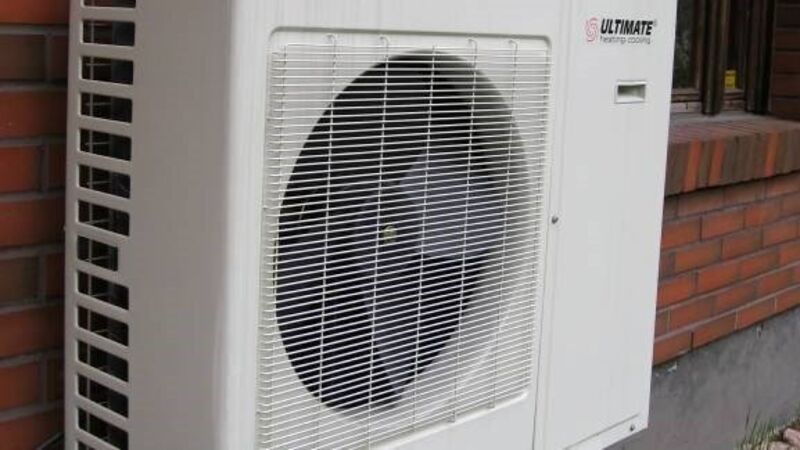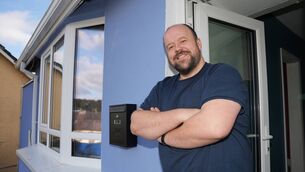From thin air: The magic of air source heat pumps

examines the options available after the rollout of up to €3,500 in SEAI grant aid for heat-pump technology to homes built before 2011.
Next month sees the highly anticipated rollout of up to €3,500 in SEAI grant aid for heat-pump technology to homes built before 2011 (checked by when your electricity meter went on).
Air-to-water heat pumps offer a retrofit solution for energy efficient, low-carbon heating. Perfectly-sized and commissioned, heat pumps are a proven, reliable, low-cost heating system in new homes. In the right situation, they can be deployed in a deep renovation to change from carbon heavy, fossil-fuel-fed boilers along with other upgrades. It’s important to take onboard that heat pumps are not boilers — different animal. Will this new technology suit your highly individual situation?
With no groundwork needed, air-to-water heat pumps (ASHP) are the least expensive entry point, so let’s start there.
Ireland’s climate is well suited to air-to-water technology in principle and there are no combustion or emission issues at home to deal with.
Heat pumps use the principles of heat transfer to warm, and (if needed) to cool the home. With ASHP, heat is transferred from the temperate air outdoors via a refrigeration process. Air is drawn in across the first of two heat exchangers. A warmed refrigerant liquid then moves this low heat indoors and through a compressor which reduces the volume of the refrigerant and increases its energy. Another heat exchanger then transforms this energy into heat suitable for your home either as underfloor heating, UFH, or through an existing system of radiators.
The cycle finishes as the refrigerant cools and goes back out through the system again.
No. All heat pumps require electricity to move air and run the compressor, and your electricity bill will go up significantly with the installation of a pump. They are therefore not zero carbon.
This is offset, of course, by the elimination of other fuel demands. NightSaver tariffs offer further savings, electricireland.ie.
Experienced energy warriors sometimes use solar photovoltaic panels (PV) or a wind turbine to keep their heat pump (single source or dual) costs low, by microgeneration, but that’s not practical in most situations. Look up the SEAI’s online fuel cost comparison calculators for more.
Heat pumps typically heat radiators to 35C-45C, far lower that the 55C-65C of oil or gas systems, but they will run constantly.
Some systems will include a built-in immersion feature to heat water up to 60C as required for safe, domestic, hot water. Again, this uses some electricity, so fluctuations in electricity prices will impact your running costs. Warranties on heat pumps are often in the 10-year range and life expectancies of 15-20 years seem reasonable with proper maintenance.
A compact, slender condenser unit sits on the ground or on brackets on a suitable exterior wall with sufficient passing room. I am advised that a south-facing wall is not required, but the side or back of the house is more discreet.
There will be some low noise created by the unit, a murmur (>50db) — but most block houses should shield acoustic nuisance.
Pumps produce more heat energy in warmer conditions and this has to be keyed into the design of your heating system and placement of unit.
Indoors, ask your supplier if your existing water tank will suffice and if the configuration will demand what is called a buffer tank to overcome inefficient ‘cycling’. Your supplier will discuss the design and positioning of these new elements, and digital controls, on a site visit.
Retrofitting is not always a plug n’ play project, but with a younger house, with superb insulation, UFH available, and/or suitable radiators, it might be.
Most heat pump suppliers suggest that Irish radiator systems are often oversized (with lots of surface area) and therefore potentially suitable for the lower water temperatures offered by an ASHP.
There are suggestions to ‘wait and watch’ after the pump goes in. Expect the system to run for longer periods and to be less reactive (if programmed times are overridden), than a boiler system. Modern timer controls are essential. All being well, a new air-to-source heat pump installation can take as little as two to three days.
Wet UFH is generally accepted by the industry as the ideal distribution end of any heat pump-fed systems. Every project is different and suitable radiators can also be used. Often in new homes with UFH, radiators are used on the upper floors, particularly where concrete flooring is not installed. With the exception of large extensions, wet UFH remains an expensive retrofit and would require lifting and replacing of all concrete floors.
Tales of disappointed expectations are not uncommon in mishandled or DIY retro-fits of UHF and heat pump technologies — use reputable suppliers and trades after engaging with an independent, SEAI-registered technical adviser (see 'SEAI Technical Assessment' section below).
ASHPs are, in general, not as energy efficient year-round as ground source (geothermal) heat pumps. Ambient outdoor temperatures are more changeable than ground temperatures.
This can lead to the coefficient of performance (COP) of a pump to be reduced in very cold weather — that is, more electricity is needed to create the same temperatures indoors.
However, for every kW of electricity used to run the compressor, 3-4 kW of heat can potentially be delivered. In winter this performance can drop to 2-2.5 units of heat for every kW of electricity — still very impressive.
The seasonal performance factor of your chosen pump, insulation levels, and air tightness, together with the method of heat delivery (radiator, UFH, etc), must be carefully considered to optimise and retain comfort levels. Bigger house — as with all heating systems – bigger bills.
The most dramatic payback and yearly savings on an air or any source of heat pump, will be when it replaces an already inefficient oil, LPG, electric, or coal-based heating system. If you have an efficient condensing natural gas heating, a heat pump (carbon sensitivities aside) may not be worth the expense to retrofit.
A feasibility study needs to take place, as the price of the heat pump system, and necessary improvements to house, may push the capital costs beyond all common sense.
Generally, an air to water system installed, commissioned and‘made-good’ will come in the area of €8,000 to €12,000 for the pump and tank fitted (suppliers’ figures).
SEAI Technical Assessment
One of the requirements for a dwelling to qualify for a heat-pump system grant, is that it has low heat loss. This is to ensure your heat-pump system performs well and your electricity bills are not too high. Before applying for a heat-pump system grant, you must engage an independent, SEAI-registered technical advisor.
The advisor will carry out an energy assessment of your home, and advise on what steps to take to make it ‘heat pump ready’, by reducing heat loss.
The Better Energy Homes programme offers a grant towards this technical assessment with the grant only payable in conjunction with the heat-pump system grant. To qualify, choose your advisor from the list of SEAI-registered persons, and then complete the heat-pump upgrades required, according to the programme rules.
The list of SEAI-registered advisors will be available from April. Please note that uninsulated homes built more than 30 years ago may require substantial and costly upgrades to qualify for a heat-pump system grant.
Updating your energy performance may not be an either/or — but a comprehensive project that could include an air source heat pump. For leaky houses, support for deep retrofits are coming down the line, following pilot projects taking place now.
It is of course a matter of available funds and intelligent use of the SEAI technical advisors, SEAI grant assistance and the Home Improvement Renovation Incentive Scheme tax relief (revenue.ie).
Improving insulation, adding double or even triple glazing, and adding solar thermal panels to work with a modern convection boiler may better suit homes built before the demands of Part L of the Building Regulations or beyond.
Adding external insulation could rake back up to €600 in annual savings according to the SEAI. Then there are pellet boilers, wood and pellet stoves with back boilers, plus wood gasification boilers that can also be retrofitted and linked to existing radiators. A-rated condensing boilers are no longer grant aided, but superb insulation measures, solar thermal and new heating controls certainly are.
- Seai.ie for more














